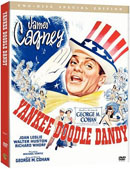
Yankee Doodle Dandy
The first movie up to bat was number 100, Yankee Doodle Dandy , made in 1943. The first step on my amamzing quest, and it had to be a goddamn musical. I can't stand musicals. It just feels really weird to me, when I'm watching a film- getting all carried away in the plot and suddenly all the characters break out into song. It just seems wrong.
So my whole musical prejudice really gave this movie an extra handicap, I was already a little sceptical. I mean let's face it- Yankee Doodle Dandy is #100. It's in the list by the skin of its teeth. The fact that it has a bunch of people dancing around in it wasn't going to help.
It was directed my Michael Curtiz, of Casablanca fame, and stars James Cagney. It tells the story of legendary song and dance man George M. Cohan, who ruled the stages of Broadway for the first part of the twentieth century-writing, producing and starring in nearly all of his musicals. Yankee Doodle Dandy begins with Cohan invited to the White house to speak to the president, I think it was one of the Roosevelt ones, to whom he tells his life story. He starts with his birth on the Fourth of July and goes on to tell of his career from arrogant child to heroic, kind hearted, millionaire celebrity.
The fact that this is the story about musical theatre made the film far more enjoyable for me. All of the musical acts are recreations from Cohan's carreer, which gives them a purpose in the plot that can't be denied. The film brought home three oscars one for Best Scoring of a Musical Picture and one for Best Sound Recording and it's easy to see why. When Cohan's career takes off, so do the musical numbers. Massive sets, long lines of dances, and talented singers abound.
Unfortunatly you'll have to wait til the second half of the movies to see all that. The first half of the film is devoted to Cohan's childhood, his relationship with his soon to be wife, Mary and his struggle to make it on broadway. The musical numbers in this part of the film are fairly dry and hundrum- something I think Curtiz did on purpose, to heighten the majesty of the acts to come. And it works.
Still, I challenge anyone not to cringe when the young version of Cohan comes out and does a little tap dance wile playing the violin on his head.
Another thing to cringe over is the blindingly bright light of patriotic dogma that this film is drenched in. Cohan's most successful songs where Grand Old flag and Over There. Both of these were used as victory songs to boost moral during World War I, and became so successful that he was eventually awarded a medal of honour for writing them. That's right. A medal of honour. And no, he didn't write the songs while hauling an injured soldier across a battlefield, or taking on a squad of Gerries with nothing but a toothpick.
The actually show a number from Grand Old Flag in the film. It was so stuffed with American Iconology I was shitting red, white and blue for a week. Civil War soldiers singing to an American Flag, dissolving into slaves singing at the feet of the Lincoln Memorial, a sea of different kinds of American workers marching past a recreation of Bunker hill. My god I'm talking about maybe three minutes of screen time here.
Of course the film was made in 1943, the war was raging and people were scared, reall scared. They needed a film like this, a film that reminded them of what it was like in the good old days, a film to fire their passion for home and country, a film to get them through.
In todays current political climate it makes you feel ill.